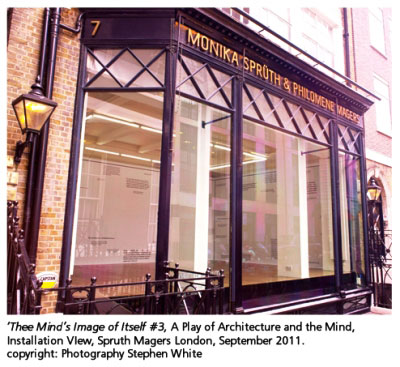- Publisher's Note
- Editorial
- In Conversation with Kanishka Raja
- Definitional Lack in an Inclusive World: Cutting Edge as Responsible Art
- Democratization Through Cutting Edge Art
- Mumbai for Cutting Edge
- Moments in Time (And a Little While After)
- In Transition
- Tip of Our Times
- Srishti School of Art, Design and Technology – A Cradle for Creative Excellence
- Cutting the Edges of Architecture
- Overview Cutting Edge
- The Matter Within: New Contemporary Art of India Featuring Photography, Sculpture and Video
- Generation in Transition: New Art from India
- Indian Master Painters at India Art Festival
- Life, Luxury & the Avant-Garde
- Mother India: The Goddess in Indian Painting
- The Last Harvest: Paintings of Rabindranath Tagore
- Asia Society Museum Presents Exhibition of Rabindranath Tagore's Paintings and Drawings
- Stieglitz and his Artists: Matisse to O'Keeffee
- Beauty of Unguarded Moments
- Across Times, Across Borders: A Report on the Chinese Art Exhibition
- A Summer in Paris
- Random Strokes
- The Emperor’s New Clothes and What It Really Means
- Understanding Versus Adulation
- What Happened and What’s Forthcoming
- Occupy Wall Street, The New Economic Depression And Populist Art
- Unconventional with Witty Undertones
- Narratives of Common Life and Allegorical Tales In Traditional and Modern Forms the Best of Kalighat 'Pats'
- Colours of the Desert
- Unbound
- I Am Here, An Exhibition of Video Self Portraits at Jaaga
- Staging Selves: Power, Performativity & Portraiture
- Venice Biennale Outreach Programme A Circle of Making I and II
- Cartography of Narratives, Contemplations on Time
- Joseph Kosuth: The Mind's Image of Itself #3' A Play of Architecture and the Mind
- Maharaja: Reminiscing the Glorious Past
- Art from Thirteen Asian Nations
- Tibetan Arms and Armor at Metrpolitan Museum of Art
- The Art of Poster Advertisement
- Unusual Angles and Facets of Museum Buildings
- Elegant Fantasies
- Art Collection and Initiatives
- Art Events Kolkata
- Mumbai Art Sighting
- Art Bengaluru
- Musings from Chennai
- Preview
- In the News
ART news & views
Joseph Kosuth: The Mind's Image of Itself #3' A Play of Architecture and the Mind
Volume: 4 Issue No: 22 Month: 11 Year: 2011
Review
by Preeti Kathuria
London. Art requires reading, mostly visual but it can also be plain textual. The eminent American conceptual artist, Joseph Kosuth's show, The Mind's Image of Itself #3 A Play of Architecture and the Mind, at the Spruth Magers gallery in London was a curiously mixed experience of reading art. A carefully chosen collection of 150 quotations installed in their full glory mask the walls of the entire gallery. His language-based conceptual practice has suggested vitality and innovation for the last five decades. The show started on September 10 and continued till October 1, 2011.
After a perplexing entrance, one reaches the raised ground floor of the gallery, with a set of large windows on one of the walls and black-vinyl lettering randomly displayed on all the other. Words like embellishment are woven in the rubric of the building. The bare wooden floor of the gallery becomes the reader's playground as one moves back and forth to read the varying dimensions of the wall-text. Some of the quotes are exceptionally appropriate for the show's context, like: “Man pursues black on white” Stephane Mallarme; “Of the elements of a room, the window is the most marvellous” Louis Kahn; “We think in generalities, we live in details” Alfred North Whitehead; “I am in a beautiful prison from which I can only escape by writing” Anais Nin.
Kosuth compiled quotations by famous personalities from a wide range of disciplines such as historians and philosophers (Plato, Martin Heidegger, Maurice-Merleau Ponty, Friedrich Nietzsche, Voltaire, Michael Foucault, Denis Diderot, David Hume, Ludwig Wittgenstein), architects (Le Corbusier, Louis Kahn), physicists (Albert Einstein), poets (Charles Baudelaire, Victor Hugo, Andre Breton), authors and novelists (James Thurber, Franz Kafka, Virgina Woolf), artists and art critics (Henri Matisse, Heinrich Wolfflin), psychoanalysts (Sigmund Freud) to name a few. The dismembered, unconnected pieces of scholarly discourse address different inklings of each discipline.
A multiplicity of thoughts, permeate the gallery space and establish an unconventional viewing experience. To some extent, literary texts support an artwork but can literary writings be substantiated as art? Is it difficult to accept simply written, undecorated, non-calligraphic words as art even when they fulfil the same function of disseminating concepts and ideas as art does? Are the quotations mapping some sort of a conceptual diagram for the viewer? Is the colourless nature of the texts challenging the viewers to not see it as art? If it is, then why has this piece been mounted in a gallery space? It might not be possible to formulate a coherent response to all these intriguing questions. However, one of the quotations on display may lead us in some direction “Under the sign of modernity the world collapses into the torn halves of subject and object. Yet they re-emerge in art not as bald opposition but as the incessant mutual inversions of the categories of form and content. In this constant play of form replacing the content and content replacing the form, meaning can only figure under the threat of its extinction” Peter Burger.
If language here is a medium then may be medium is the message of this exhibition. It is like seeing and articulating a relatively miniscule form from an overpowering content. The gentle but steady expression has a binary indication towards the play of architecture and mind. Possibly an absence of a coherent motive behind the thoughts spread across the walls creates a space for the visitor to draw connections, dwell and debate.